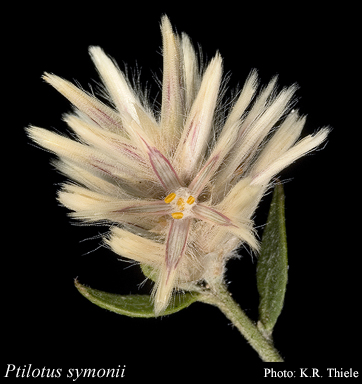- Reference
- Trans.Roy.Soc.South Australia 92:33-36 (1968)
- Conservation Code
- Not threatened
- Naturalised Status
- Native to Western Australia
- Name Status
- Current
Procumbent or ascending perennial, herb, 0.1-0.5 m high. Fl. red-cream-white, Jul to Nov. Sandy soils. Limestone plains, floodplains, low rocky rises.

Scientific Description
Perennial herbs, stems several, more or less prostrate, persistently hairy or glabrescent, with nodose hairs. Leaves present, 3-40 mm long, 0.5-5 mm wide, glabrescent or glabrous, with nodose hairs; basal rosette absent; cauline leaves alternate. Spikes white, hemispherical or spherical, solitary, with densely arranged flowers. Bracts 4.5-4.8 mm long, coloured, hairy, not awned or mucronate, with an obscure midrib. Bracteoles 7-8 mm long, coloured, hairy, not awned or mucronate, with an obscure midrib. Outer tepals 11-11.4(-12) mm long, not entire. Inner tepals 9-9.3 mm long, glabrous within. Style (1-)1.1-1.2(-1.3) mm long, curved or straight, obliquely fixed to ovary. Distribution: South West and Eremaean Botanical Region; IBRA regions: Coolgardie, Hampton, Nullarbor.
Distribution
- IBRA Regions
- Coolgardie, Hampton, Mallee, Nullarbor.
- IBRA Subregions
- Eastern Mallee, Hampton, Mardabilla, Nullarbor Plain.
- Local Government Areas (LGAs)
- Dundas.